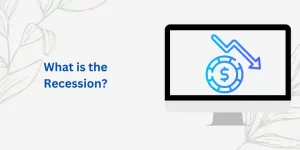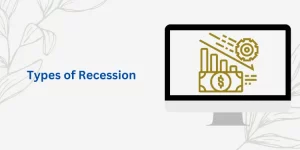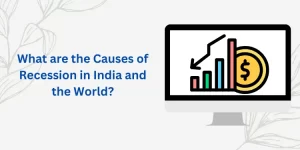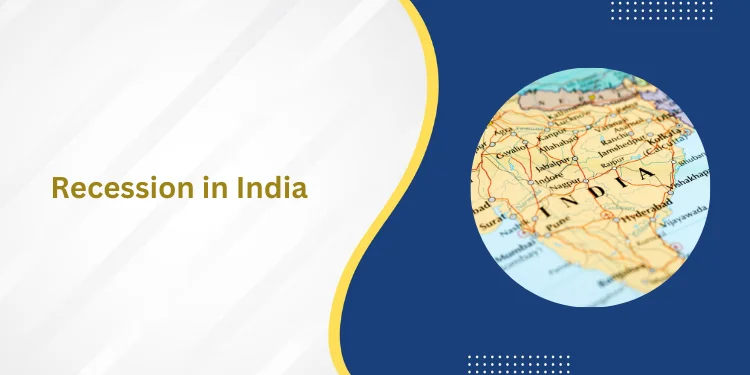Table of Contents
ToggleIntroduction to Recession in India
Recession is a cause of the falling economy and negatively growing GDP for two consecutive quarters. It is a temporary period and lasts for some months for a less severe recession. Recession is the most challenging time for any country, and the world’s largest economy fears a predicted recession in the coming years. The inflation, energy crisis due to the Russia-Ukraine war, and increasing interest rates are shifting the world to the possibility of facing a recession by 2023.
Another severe note contributing to the abuzz Recession is massive tech layoffs, mainly in the US market. There is no second thought the US or global Recession will negatively affect the Indian economy. From rising fuel prices and interest rates to dropping currency are the factors that may lead to a Recession in India. The predicted Global Recession may show its marks on the coming finance budget of Finance Minister “Nirmala Sitaraman“.
India has faced 5 significant recessions and is likely to face the next predicted one in late 2023 or early 2024; as per the government, they have backups and plans to save the Indian economy from its fall. Mr. Rajeev Kumar, Vice-President of Niti Ayog, said, “India will not be affected by the recession, and India will grow its economy by 6% to 7% by 2023-2024.”
The early 4 recession in India were primarily due to bad monsoon and globally increased fuel prices. There is a dilemma for the uncertain Recession in India. With this blog, I am trying to shade the clouds by highlighting the current situation of the Recession in India, the meaning of the Recession, and many more.
What is the Recession?

A recession is a slow or massive fall in the economy successively for two or more quarters. When Domestic growth reduces with reduced confidence of customers and businesses, the situation comes from the Recession staying for a month or more, but it has long-lasting results.
NBER (National Bureau of Economic Research) in the United States defined Recession as a declining economic period between two high peaks of the Business Cycle that remain for at least 2 quarters, but it is not a fixed formula.
The prolonged and significant decline of economic growth results in Recession and there is no single parameter to measure it. Unemployment and low salary or no salary also accumulate to Recession. There are various parameters to define a recession period for a country or the world; some of them are:
- Unemployment
- More inflation with decreasing currency rate.
- Industrial Production
- Retails
- Negative GDP for a minimum of 8 months
Unemployment is the biggest output of Recession and it takes months or even years to stabilize the positive economic growth after and during the recession period. Countries use monetary and fiscal policies defined by their central bank to overcome the recession period.
Types of Recession

Recession is the most challenging time for every country, and converting negative GDP to a healthy economy is difficult. The shapes of business graphs define the types of recession and may help businesses decide positively.
1. Boom and Bust Recession
Economies face many ups and downs in their growing GDP. In the economic boom, the economy runs above the expected long-run growth rate resulting in inflation. As the economy booms, the situation is unsustainable, and the central bank or other government agencies try to control it by tightening the fiscal policy or increasing the interest rate.
It is a short-term recession and can be overcome by reducing inflation. The customer, during this situation, tries to save more by spending less on his debts. An example of a boom and bust recession is the 1990-92 UK recession.
2. Balance Sheet Recession
It is termed my economist Richard Koo. A balance sheet recession occurs when a bank or business sees a significant decline in its balance sheet due to bad loans or increasing debts. When there is an overburden of debt on an economy, the situation comes out as a balance sheet recession.
It is a long-term situation with long-lasting effects with falling asset prices like reduced house prices and more. It is difficult to eliminate the balance sheet recession with shifting customer priorities. To clear the balance sheet, customers save more money with less spending. Japan 1990 faced a balance sheet recession, and its long-term GDP growth took a long time to recover. The 2008 recession was also a balance sheet recession.
3. Depression
The continued recession for more than a year resulted in depression. The long and more lasting recession converts into depression. It has severe effects, resulting in 10% GDP growth, unemployment going to 30%, and an unstructured economy.
The scariest effect of depression or the hardest recession is unemployment. The recession of the 1930s was a depression.
4. Supply Side Shock Recession
This recession is not long-lasting and takes its shape when there is a decrease in the supply of highly dependent things or commodities like oil. It results from war, natural calamity, or some health crisis. An example was the recession of 1973 when oil prices were as high as triple the base price. At that time, the world depended on oil for most of its energy and business. But, with time, countries discovered alternative oil sources.
The type of recession is identified after the occurrence of some new recession as it is unpredictable and countable. The latest black swan recession, COVID-19 time, was completely different and unexpected.
What are the Causes of Recession in India and the World?

There is no one defined reason for the recession in India and worldwide. Many factors played a significant role in previous recessions in India.
With a high inflation rate and unemployment as low as 3.7% is more likely to welcome the United States for the next recession year. It is a 50-50 assumption for a US recession, and the World Bank entirely decides it. After lots of research of the previous recession in India and the world, the most common reasons for any recession in India and the world are as follows:
1. Rising Interest Rate
The continuous increase in the interest rate hinders the flow of liquidity. The rising home loans and interest rates make it difficult for the ordinary- man to have an easy day-to-day life. The continuous increase in the interest rate enhances the borrowing cost and reduces the demand.
The rising interest rates contributed to the 1980 recession.
2. Deflation
The notably lower prices of goods and commodities will reduce their value. Deflation is one of the reasons for recession. Lowering costs means people will wait for more price reductions, which weakens the currency. The most prominent example is the economic crisis in Sri Lanka.
3. Inflation
Inflation makes it challenging for commoners to fulfill their basic needs. The continuous inflation will, in the end, result in a recession as there will be less money flow and more unemployment.
4. Weak Bank Management
Banks play a prominent role in the steady growth of an economy. If Bank fails to manage its money flow and has more bankruptcies, DeMat accounts, and frauds, it leads to a recession situation for a country.
The 1990 crisis was due to poor bank savings and loans. Over 1000 banks failed to explain the loans and were involved in illegal activities.
5. Unbalanced Manufacture and Demand
When the manufacturing sector slows down due to less demand, it will affect the business and lives of many connected people.
This factor was a pre-symptoms of the 2008 recession; by October 2007, the orders for durable goods started to de-accelerate to their minimum level. These are some of the reasons for recession; some others that may be causes of recessions are reducing housing prices and sales, economic crisis, poor wages, and price control.
Industries Affected by Recession
Domestic or global recession affects the country’s various sectors and industries. It is hard to define which industries have severe effects of the recession; the impact depends on the customer’s dependency and requirement.
Let’s closely look at some of the most vulnerable industries that were hardly hit by past recessions.
1. Real Estate
During the recession, customers shift towards saving money, and they do not want to spend money on housing or other construction work. The recession affects real estate agents, workers, and everyone who is somehow connected with this industry.
During the pandemic, companies started work-from-home culture, reducing the demand for offices.
2. Tourism
The tourism sector is directly dependent on travelers, and a person thinks to travel only when he has extra income. During the recession, with high inflation and low liquidity, spending money for fun or relaxing activities is not feasible.
3. Retail
Retail stores with essential items can survive, or else customers tightly pack their budget for unnecessary things.
There were heavy losses to the retail industry during the recession in India and worldwide.
4. Restaurants
In the last dark swan recession(COVID-19),2021, many restaurants in India were closed because the pandemic did not allow physically outgoing people. Many restaurants were locked, and people were unemployed.
The owners who delivered at home somehow survived, but the lockdown did not give way to this idea. With the recession, there is more unemployment and reduced liquidity, hampering the flow of the restaurant industry.
5. IT sector
The US recession of 2008 showed a drastic decline in the IT sector, this industry completely collapsed, and its effects were seen for many years. But now, it is strong enough to survive the recession.
6. Manufacturing
The demand and supply of many items were reduced to their lowest level during the recession in India and worldwide. It is tough to keep the business going as the demand for some things during the recession was almost zero. This manufacturing industry saw many ups and downs during the recession, and many small businesses locked their doors.
Is 2023 the Recession in India?
The picture for the recession in 2023 is very blurry, as there are 50-50 chances for it. The growing uncertainties and negative economic growth in the US, Japan, Europe, and China predict a recession by 2023.
The predicted recession may negatively affect the Indian economy, but we can grow 6-7% in 2023-24, said former Vice-President of Niti Ayog, Mr. Rajiv Kumar. He added that Indians are relying less on imported goods, so the reducing Indian rupee value will not adversely affect the growth during the predicted recession in India and the globe.
The World Bank projected Indian growth of 6.5% in 2023, which is one point lower as of June 2022. Many Indian CEOs stated that there would be a negative impact of the predicted recession, but Indian startups and companies will cover that in a short period. Among all saying, we can say that the Global recession may or may not impact the Indian economy directly, but it will have indirect effects.
Reasons for the Globally Predicted Recession
The economic crisis predicted by economists in late 2023 or early 2024 is due to the pandemic when the GDP was drastically influenced.
The main reasons for the saying recession in 2023 are:
- Increasing fuel prices and energy demand caused by the Russia-Ukraine war.
- The World Bank increased the interest rate due to rising inflation. To meet the inflation rate, there is exponential growth in the interest rate. The Financial crisis will hamper the development of many developing countries.
- The rising inflation rate is a severe note for all countries. The Central banks are increasing their interest rates which are as high as ever in the last 5 years.
Central banks must focus on their fiscal policies, demand, and supply chain, have a solid global trade marketing, and other influencing factors.
Darkest Global Recession Year 2007-2009
 The most prolonged and significant recession began in December 2007 and lasted until June 2009. This recession is called the “Greatest Recession” and had great severity after the great depression of the 1930s in the United States.
The most prolonged and significant recession began in December 2007 and lasted until June 2009. This recession is called the “Greatest Recession” and had great severity after the great depression of the 1930s in the United States.
- The US economic countdown started when the housing market shifted from boom to bust during the great recession of 2007-09.
- The USA faced a tremendous loss in mortgage-backed securities (MBS) and other derivatives.
This recession had hardly hit the world by beating the world’s biggest economy. The recession was very severe, and the following were the consequences of the downturn in the USA.
- The domestic GDP rate fell to 4.5% from its peak in 2007 to its trough in 2009.
- The US GDP dropped by 0.3% in 2008 and 2.8% in 2009.
- Highly increased unemployment, and its rate from 5% in 2207 had risen to 9.5% by June 2009.
- Home prices declined to their lowest level of 5% by 2009.
- S&P 500 index dropped by $69 trillion to $55 trillion
The Indian economy was affected by the financial crisis, and the impact of the recession in India was the GDP dropped from 9% to 7.8%. The 2011 report submitted by the Financial crisis Inquiry Commission mentioned that the recession was avoidable and was due to:
- The US government failed to regulate the financial industry.
- People, Corporate, and landmarks were taking many borrowings.
- With the lower housing rates in 2005, banks started to provide loans without proper paperwork and investigation, and the housing industry started attracting more and more customers without appropriate planning.
The banks, in the end, saw more borrowings, and to cover it, they increased the interest rates from 2.25% to 5.25%, which converted into a recession and financial crisis.
The recession was very loud, and to recover from that, Federal and Central banks came up with tightly coupled monetary policies and some different policies, and the economy got on track by the second half of 2009.
Biggest Time for Recession in India: 2021 (COVID-19)
COVID-19 shows Indian citizens a very dark time, and due to two consecutive lockdowns, India f
ormally entered into recession, with GDP shrinking by 7.5%.
This was the first technical recession in India in Indian recession history, and it was an uncertain recession in India with uncontrollable factors. There was unemployment not in all sectors but in scattered sectors. India faced the most challenging time, losing many lives and witnessing too many business shutdowns.
- Compared to the world, India faced a more significant decline in its GDP, with 24.4% in April-June 2021.
- In 2020-21 the Indian economy contracted by 7.4%, which was very low than other countries during the pandemic.
- In 2020/21, the Indian economy faced a high contraction compared to the previous recession in India; there was more unemployment and a poverty ratio.
- The unemployment rate in 2020 reached 7.1%, which was at its lowest level. The poorer section became poorer, and the middle class declined with a reduced salary.
Indians are facing the post-pandemic consequences and trying to bring their lives back on track. The shattered families and orphan children are the most significant scars of COVID-19. But, the world’s largest economy is gaining speed and trying to help citizens with more startups and working with new technologies.
History of Recession in India
A recession is counted when there is negative GDP for consecutively two quarters. India faced its first technical recession during the Pandemic time, and apart from that, there were 4 other recessions in India. All have different reasons, with the common factor being bad monsoons is the history of recession in India.
1. 1957-58: Recession in India
This was the first recession in India. There was negative GDP growth of 1.2%. The reasons behind this recession in India are bad monsoons resulting in drought conditions and increased prices, ballooning import bills, and war with China.
2. 1966-67: Recession in India
India faced two consecutive drought years when food grain production decreased by 20%, and the population started starving. In that condition, India got food help from the USA to help the people. The other factors that contributed to the recession in India include the India-china war in 1962 and the India-Pakistan war in 1965.
3. 1973: Recession in India
India faced an energy crisis as the OAPEC proclaimed the import of oil to the Israel-supporting nations, and as a result, oil prices increased by 400%. That was from $3 to $12. This created a hole in the Indian import bill with $414 million in 1072-73 to $900 million till 1073-74.
4. 1980: Recession in India
This was another recession in India and around the world due to reduced oil production due to the Iranian revolution. This resulted in increased oil prices and more money India spent to import the oil.
Summarizing
The COVID-19, 2020 first technical recession in India, resulted in unemployment; less demand results in more layoffs to save the company balance. More Poverty and people lose their businesses. Except for the Pandemic time, the reasons for a recession in India include bad monsoon conditions, energy crisis, and global recessions.
A falling economy for two consecutive quarters can be considered a recession, but there are no defined measures to rate and identify the cause of the recession. To deal with the recession in India and World, Central banks regulate fiscal and monetary policies.
NOTE: For such interesting posts Click Here BLOGS
Frequently Asked Question’s
Is there any recession coming in India?
There is no such confirmation of recession in India. Although India has a negatively growing economy, India will increase by 6% to 7% by 2023, which will help in case of a global recession in 2023.
COVID-19 has adversely affected the Indian economy by reducing the GDP rate, causing more unemployment, many small businesses have shut down, and it was a terrifying time with emergency medical help.
Recession is counted when an economy faces losses for two consecutive years, and luckily after the pandemic, the Indian economy is moving with more possibilities and new startups.
Is a recession coming in 2023 India?
The world is expecting a recession by the end of 2013 or at the start of 2024, but it is not confirmed. India will not be untouched by its adverse effects if a recession hits globally.
The recession will lead to higher interest rates and slower international trading. Mr. Rajiv Kumar (Vice-President of Niti Ayog) said in an interview that the Indian economy would not be affected by the coming recession as it will grow by 6% to 7% by the next financial year.
The reasons for the next predicted recession include high-interest rates by the Central Bank to meet inflation and many other side reasons like the pandemic energy crisis due to the Russia-Ukraine war.
How long will recession last?
There is no defined period for a recession; it depends on its severity and how fastly the economy stabilizes. In general, a mild slowdown lasts for around a year.
The most extensive and most severe recession was in 2007-08 due to the US housing policies, which lasted for 18 months. Even after recovery, its effects were visible in the US and other countries economies.
Long-duration pre and post-recession situations contribute to a recession in India and the world. It is not a one or two-month activity that leads to a recession.
Which sector does well in recession?
A recession is a prolonged negative economic time, considered when the GDP declines for two consecutive quarters. During and after the recession, almost all industries face its consequences.
The recession in India mainly affects the agriculture sector. The sector not affected by the downturn includes the essential services industries like livelihood suppliers and health care. Other than these, all are vulnerable to the recession in India and the globe.
The industries that are influenced mainly by the recession in India and the world include real estate, restaurants, tourism, agriculture, manufacturing, and retail stores.
When did India last have a recession?
- Declining GDP by 24.4%.
- Unemployment reached its lowest level of 7.1%
- Indian economy contracted by 7.4%
- Many businesses closed down and this affected the daily wages earning class.
- It was a medical emergency in India and the World.
Why Recession in India?
India had seen 5 major recessions with the latest one being during pandemic time. But the predicted recession of 2023 will less likely to impact the Indian economy due to its uncoupling economy with the world’s strongest economy.
With high inflation rate and unemployment as low as 3.7% is more likely to welcome the United States for the next recession year. It is a 50-50 assumption for a US recession and it is completely decided by the World Bank.
Moving to India, it is found that India seems to be safer from the coming recession but if a global recession will come then it affects the job in IT sectors. As the Indian IT sector mostly relies on US and euro markets, most IT professionals are working for foreign companies.
The chances of recession in India is low as Indian fiscal is to grow by 6% as stated by the former Vice-President of Niti Ayog, Mr. Rajeevl. Kumar.













